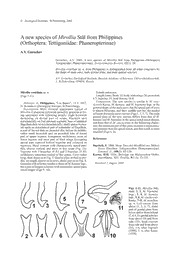
A new species of Mirollia Stеl from Philippines (Orthoptera: Tettigoniidae: Phaneropterinae) PDF
Preview A new species of Mirollia Stеl from Philippines (Orthoptera: Tettigoniidae: Phaneropterinae)
© Zoological Institute, St.Petersburg, 2003 A new species of Mirollia Stål from Philippines (Orthoptera: Tettigoniidae: Phaneropterinae) A.V. Gorochov Gorochov, A.V. 2003. A new species of Mirollia Stål from Philippines (Orthoptera: Tettigoniidae: Phaneropterinae). Zoosystematica Rossica, 12(1): 28. Mirollia rostellum sp. n. from Philippines is distinguished from all other congeners by the shape of male cerci, male genital plate, and male genital sclerites. A.V. Gorochov, Zoological Institute, Russian Academy of Sciences, Universitetskaya nab. 1, St.Petersburg 199034, Russia. Mirollia rostellum sp. n. Female unknown. (Figs 7-11) Length (mm). Body 15; body with wings 26; pronotum 4.7; tegmina 19; hind femora 10.8. Comparison. The new species is similar to M. cinc- Holotype. M, Philippines, “Los Banos”, 15.V. 1917, ticornis Karny, M. hamata, and M. bigemina Ingr. in the N. Ikonnikov (Zoological Institute, St.Petersburg). general shape of the male cerci, but the apical part of cerci Description. Male. General appearance typical of is almost bifurcate, and their middle part has the medial Mirollia. Coloration yellowish (possibly, greenish in liv- inflation distinctly more convex (Figs 1, 3, 5, 7). The male ing specimen) with following details: slight brownish genital plate of the new species differs from that of M. darkening on dorsal part of scape, blackish spot hamata and M. bigemina in the apical notch much deeper, dorsolaterally on 2nd antennal segment, base of antennal and from that of M. cincticornis in the following charac- flagellum dark brown dorsolaterally, small sparse brown- ters: the narrowest part of this plate occupies a more proxi- ish spots on dorsolateral part of remainder of flagellum, mal position than the apical notch, and this notch is more a pair of brown dots on pronotal disc before its middle, rounded (Figs 6, 8). rather small brownish spot on proximal lobe of dorsal part of upper tegmen, transparent stridulatory areas of lower tegmen and most part of hind wings (excepting References apical part exposed behind tegmina and coloured as tegmina). Head rostrum with characteristic apical part: Ingrisch, S. 1998. Neue Taxa der Mirolliini aus Südost- thin, almost vertical, and more or less acute (Fig. 11). Asien (Ensifera: Tettigonioidea: Phaneropteridae). Tegmina with 3 branches of RA and 2 branches of RS; Entomol. Z., 108(3): 85-128. stridulatory apparatus typical of this genus. Cerci rather Karny, H.H. 1926. Beiträge zur Malayischen Ortho- long; their shape as in Fig. 7. Genital plate arched in pro- pterenfauna, XIII. Treubia, 9(1-3): 12-151. file; its length almost as in cerci, distal part as in Fig. 8. Genitalia with sclerites similar to those of M. hamata Ingr., Received 2 August 2003 but a pair of longest sclerites with denticulate apical parts much longer (Figs 9, 10). Figs 1-11. Mirollia Stål, male. 1, 2, M. bigemina Ingr.; 3, 4, M. hamata Ingr.; 5, 6, M. cincticornis Karny; 7-11, M. rostellum sp. n. Left cercus from above (1, 3, 5, 7); distal part of genital plate from below and/or from behind (2, 4, 6, 8); genital sclerites from above (9) and from side (10); head rostrum from side and from above (11). 1-4, after Ingrisch (1998); 5, 6, after Karny (1926).
